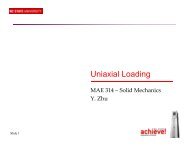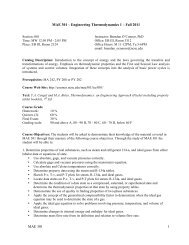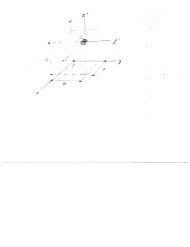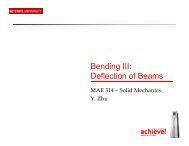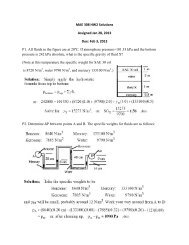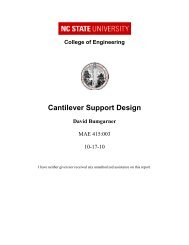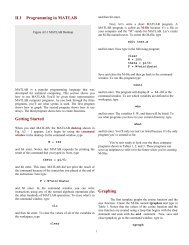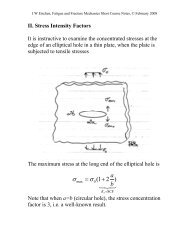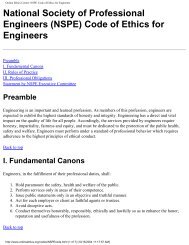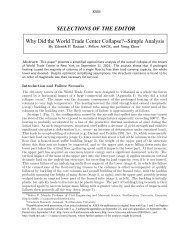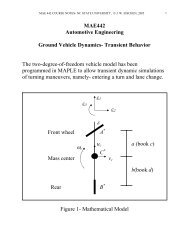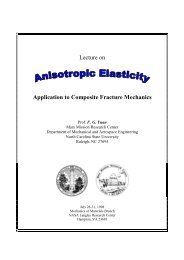Lecture 5 Contact Stress
Lecture 5 Contact Stress
Lecture 5 Contact Stress
Create successful ePaper yourself
Turn your PDF publications into a flip-book with our unique Google optimized e-Paper software.
<strong>Contact</strong> <strong>Stress</strong><br />
(3.19)<br />
MAE 316 – Strength of Mechanical Components<br />
Y. Zhu<br />
1<br />
<strong>Contact</strong> <strong>Stress</strong>
Introduction<br />
Where does contact stress occur<br />
Ball bearings<br />
Railroad wheel on a track<br />
Bowling ball on an alley<br />
Want to find the local stress at the point (region) of<br />
contact.<br />
This will depend on elasticity of contacting materials (E &<br />
ν), loading, and geometry.<br />
2<br />
<strong>Contact</strong> <strong>Stress</strong>
Spherical <strong>Contact</strong> Surfaces (3.19)<br />
Where a = radius of circular contact area and p o = p max =<br />
maximum pressure.<br />
3<br />
<strong>Contact</strong> <strong>Stress</strong>
Spherical <strong>Contact</strong> Surfaces (3.19)<br />
For spheres in contact, the contact patch is circular<br />
(radius a).<br />
a<br />
<br />
3<br />
3F<br />
(1 <br />
) / E (1 <br />
) / E<br />
8 1/ d 1/<br />
d<br />
2 2<br />
1 1 2 2<br />
1 2<br />
Where:<br />
F = force pressing the two spheres together<br />
d 1 and d 2 = diameters of the two solid spheres in contact<br />
E 1 , ν 1 , E 2 , ν 2 = respective elastic constants of the two spheres<br />
4<br />
<strong>Contact</strong> <strong>Stress</strong>
Spherical <strong>Contact</strong> Surfaces (3.19)<br />
The maximum contact pressure is<br />
The stress distribution is<br />
p<br />
<br />
3F<br />
2 a<br />
max 2<br />
<br />
z 1 1 <br />
1 <br />
<br />
1 2 x<br />
y<br />
pmax <br />
1 tan (1 )<br />
<br />
<br />
2<br />
<br />
a z a 21 ( za)<br />
<br />
<br />
pmax<br />
3 z<br />
<br />
2<br />
1 ( za)<br />
<br />
12<br />
<br />
0<br />
1 1<br />
max 13 23 yz<br />
xz<br />
( 1 3) ( 2 3)<br />
2 2<br />
xy<br />
5<br />
<strong>Contact</strong> <strong>Stress</strong>
Spherical <strong>Contact</strong> Surfaces (3.19)<br />
Figure 3-37 in the<br />
textbook shows the<br />
magnitude of the stress<br />
components below the<br />
surface as a function of<br />
p max of contacting<br />
spheres with ν = 0.3.<br />
6<br />
<strong>Contact</strong> <strong>Stress</strong>
Cylindrical <strong>Contact</strong> Surfaces (3.19)<br />
2b<br />
l<br />
Where b = half-width of rectangular contact area and p o = p max<br />
= maximum pressure.<br />
7<br />
<strong>Contact</strong> <strong>Stress</strong>
Cylindrical <strong>Contact</strong> Surfaces (3.19)<br />
For cylinders in contact, the contact patch is rectangular<br />
(half-width b).<br />
b<br />
<br />
2F<br />
(1 <br />
) / E (1 <br />
) / E<br />
l 1/ d 1/<br />
d<br />
2 2<br />
1 1 2 2<br />
1 2<br />
Where:<br />
l = length of contact area<br />
F = force pressing the two spheres together<br />
d 1 and d 2 = diameters of the two solid spheres in contact<br />
E 1 , ν 1 , E 2 , ν 2 = respective elastic constants of the two spheres<br />
8<br />
<strong>Contact</strong> <strong>Stress</strong>
Cylindrical <strong>Contact</strong> Surfaces (3.19)<br />
The maximum contact pressure is<br />
The stress distribution is<br />
p<br />
max<br />
<br />
2F<br />
bl<br />
<br />
<br />
2<br />
1<br />
<br />
x<br />
2 pmax<br />
1 ( zb)<br />
zb<br />
<br />
<br />
<br />
2<br />
1<br />
2( zb)<br />
<br />
p<br />
2<br />
<br />
2<br />
1 ( zb)<br />
pmax<br />
3<br />
z<br />
<br />
2<br />
1 ( zb)<br />
2 y max<br />
zb<br />
<br />
<br />
<br />
9<br />
<strong>Contact</strong> <strong>Stress</strong>
Cylindrical <strong>Contact</strong> Surfaces (3.19)<br />
Figure 3-39 in the<br />
textbook shows the<br />
magnitude of the stress<br />
components below the<br />
surface as a function of<br />
p max of contacting<br />
cylinders with ν = 0.3.<br />
10<br />
<strong>Contact</strong> <strong>Stress</strong>
Example<br />
Two carbon steel balls, each 30 mm in diameter, are<br />
pressed together by a force F. Find the maximum values<br />
of the principal stress and the maximum shear stress if F<br />
= 50 N, ν = 0.3, and E = 207 GPa.<br />
11<br />
<strong>Contact</strong> <strong>Stress</strong>




